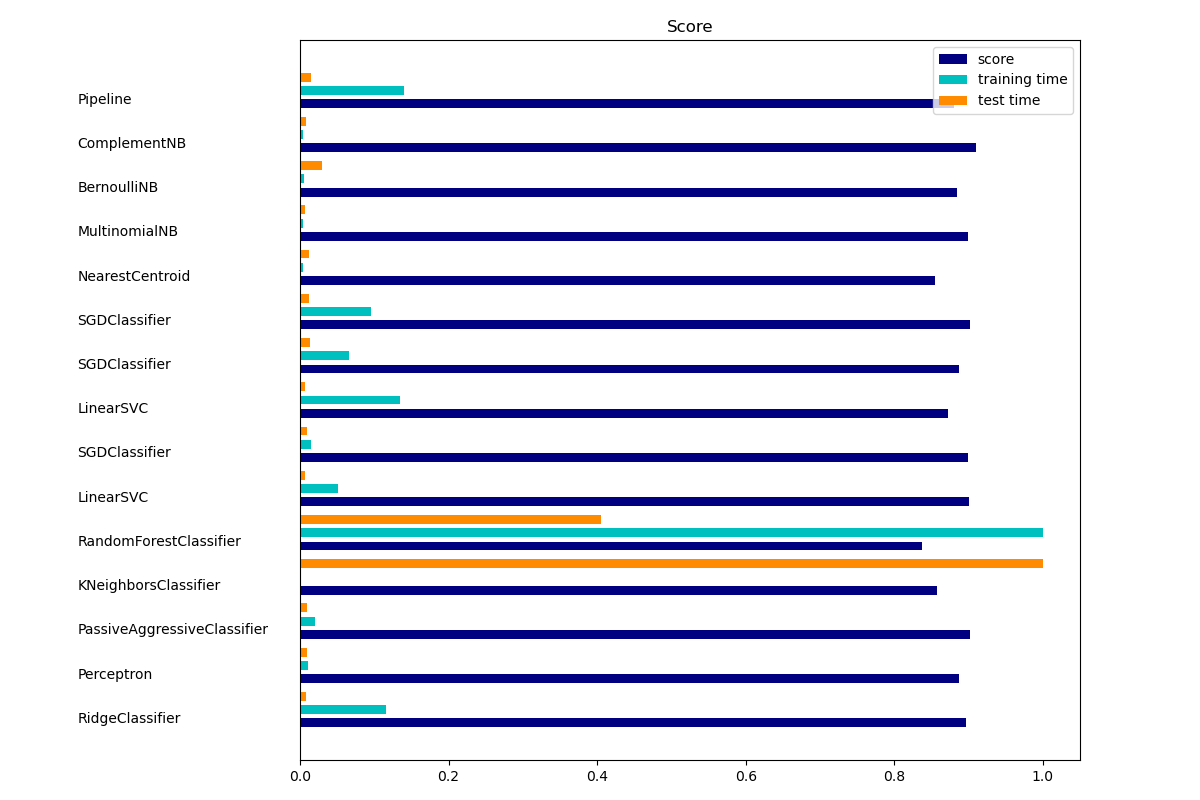sklearn.linear_model.RidgeClassifier¶
class sklearn.linear_model.RidgeClassifier(alpha=1.0, *, fit_intercept=True, normalize=False, copy_X=True, max_iter=None, tol=0.001, class_weight=None, solver='auto', random_state=None)
使用Ridge回归的分类器。
该分类器首先将目标值转换为{-1, 1},然后将问题视为回归任务(在多类情况下为多输出回归)。
在用户指南中阅读更多内容。
| 参数 | 说明 |
|---|---|
| alpha | float, default=1.0 正则强度,必须为正浮点数。正则化改善了问题的状况,并减少了估计的方差。较大的值表示更强的正则化。在其他线性模型中,Alpha对应于 1 / (2C),例如 LogisticRegression或sklearn.svm.LinearSVC |
| fit_intercept | bool, default=True 是否计算此模型的截距。如果设置为false,则在计算中将不使用截距(如数据已经中心化)。 |
| normalize | bool, default=Falsefit_intercept设置为False 时,将忽略此参数。如果为True,则在回归之前通过减去均值并除以l2-范数来对回归变量X进行归一化。如果你希望标准化,请先使用 sklearn.preprocessing.StandardScaler,然后调用fit 估算器并设置normalize=False。 |
| copy_X | bool, default=True 如果为True,将复制X;否则,X可能会被覆盖。 |
| max_iter | int, default=None 共轭梯度求解器的最大迭代次数。默认值由scipy.sparse.linalg确定。 |
| tol | float, default=1e-3 优化算法的精度。 |
| class_weight | dict or ‘balanced’, default=None 以 {class_label: weight}的形式与类别关联的权重。如果没有给出,所有类别的权重都应该是1。“balanced”模式使用y的值来自动调整为与输入数据中的类频率成反比的权重。如 n_samples / (n_classes * np.bincount(y)) |
| solver | {‘auto’, ‘svd’, ‘cholesky’, ‘lsqr’, ‘sparse_cg’, ‘sag’, ‘saga’}, default=’auto’ 用于计算例程的求解器: - “auto”会根据数据类型自动选择求解器。 - “ svd”使用X的奇异值分解来计算Ridge系数。对于奇异矩阵,比“ Cholesky”更稳定。 - 'cholestsky'使用标准的scipy.linalg.solve函数获得封闭形式的解决方案。 - 'sparse_cg'使用scipy.sparse.linalg.cg中的共轭梯度求解器。作为一种迭代算法,对于大规模数据(可以设置 tol和max_iter),此求解器比“ Cholesky”更合适。- “ lsqr”使用专用的正则化最小二乘算法scipy.sparse.linalg.lsqr。它是最快的,并且使用了迭代过程。 - “sag”使用随机平均梯度下降,而“saga”是它的无偏和更灵活的版本。这两种方法都使用了迭代过程,当n_samples和n_features都很大时,通常比其他求解器更快。请注意, “sag”和“saga”的快速收敛只能保证在具有大致相同规模的特性上。你可以使用sklearn.preprocessing中的缩放器对数据进行预处理。 *0.17版本中的新功能:*随机平均梯度下降求解器。 0.19版中的新功能: SAGA求解器。 |
| random_state | int, RandomState instance, default=None 在 solver=='sag'或'saga'时使用,用于随机打乱数据。有关详细信息,请参见词汇表。 |
| 属性 | 说明 |
|---|---|
| coef_ | ndarray of shape (1, n_features) or (n_classes, n_features) 决策函数中特征的系数。 当给定问题为二分类时, coef_形状为(1,n_features)。 |
| intercept_ | float or ndarray of shape (n_targets,) 决策函数中的截距。如果设置 fit_intercept = False,则截距为0.0 。 |
| n_iter_ | None or ndarray of shape (n_targets,) 每个目标的实际迭代次数。仅适用于sag和lsqr求解器。其他求解器将返回None。 |
| classes_ | ndarray of shape (n_classes,) 类别标签。 |
另见
岭回归。
带有内置交叉验证的Ridge分类器。
注
对于多类别分类,以“一对多”的方法训练n_class分类器。具体而言,这是通过利用Ridge中的多变量响应支持来实现的。
示例
>>> from sklearn.datasets import load_breast_cancer
>>> from sklearn.linear_model import RidgeClassifier
>>> X, y = load_breast_cancer(return_X_y=True)
>>> clf = RidgeClassifier().fit(X, y)
>>> clf.score(X, y)
0.9595...
方法
| 方法 | 说明 |
|---|---|
decision_function(self, X) |
预测样本的置信度得分。 |
fit(self, X, y[, sample_weight]) |
拟合Ridge分类器模型。 |
get_params(self[, deep]) |
获取此估计器的参数。 |
predict(self, X) |
预测X中样本的类别标签。 |
score(self, X, y[, sample_weight]) |
返回给定测试数据和标签上的平均准确度。 |
set_params(self, **params) |
设置此估计器的参数。 |
__init__(self, alpha=1.0, *, fit_intercept=True, normalize=False, copy_X=True, max_iter=None, tol=0.001, class_weight=None, solver='auto', random_state=None)
初始化self, 请参阅help(type(self))以获得准确的说明。
decision_function(self, X)
预测样本的置信度得分。
样本的置信度分数是该样本到超平面的符号距离。
| 参数 | 说明 |
|---|---|
| X | array_like or sparse matrix, shape (n_samples, n_features) 样本数据。 |
| 返回值 | 说明 |
|---|---|
| array, shape=(n_samples,) if n_classes == 2 else (n_samples, n_classes) 每个(样本,类别)组合的置信度得分。在二分类情况下,self.classes_ [1]的置信度得分> 0表示将预测该类。 |
fit(self,X,y,sample_weight = None )
[源码]
拟合Ridge分类器模型。
| 参数 | 说明 |
|---|---|
| X | {ndarray, sparse matrix} of shape (n_samples, n_features) 训练数据 |
| y | ndarray of shape (n_samples,) 目标标签。 |
| sample_weight | float or ndarray of shape (n_samples,), default=None 每个样本的权重,如果使用浮点数,每个样品的权重都相同。 0.17版中的新功能:sample_weight支持Classifier。 |
| 返回值 | 说明 |
|---|---|
| self | object 估计器的实例。 |
get_params(self,deep = True )
[源码]
获取此估计器的参数。
| 参数 | 说明 |
|---|---|
| deep | bool, default=True 如果为True,返回此估计器和所包含子对象的参数。 |
| 返回值 | 说明 |
|---|---|
| params | mapping of string to any 参数名称映射到其值。 |
predict(self, X)
[源码]
预测X中样本的类别标签。
| 参数 | 说明 |
|---|---|
| X | array_like or sparse matrix, shape (n_samples, n_features) 样本数据 |
| 返回值 | 说明 |
|---|---|
| C | array, shape [n_samples] 每个样本的预测类别标签。 |
score(self,X,y,sample_weight = None )
[源码]
返回给定测试数据和标签上的平均准确度。
在多标签分类中,这是子集准确性,这是一个严格的指标,因为你需要为每个样本正确预测对应的标签集。
| 参数 | 说明 |
|---|---|
| X | array-like of shape (n_samples, n_features) 测试样本。 |
| y | array-like of shape (n_samples,) or (n_samples, n_outputs) X的真实标签。 |
| sample_weight | array-like of shape (n_samples,), default=None 样本权重。 |
| 返回值 | 说明 |
|---|---|
| score | float 预测标签与真实标签的平均准确度 |
set_params(self, **params)
[源码]
设置并验证估计器的参数。
| 参数 | 说明 |
|---|---|
| **params | dict 估计器参数。 |
| 返回值 | 说明 |
|---|---|
| self | object 估计器实例。 |





